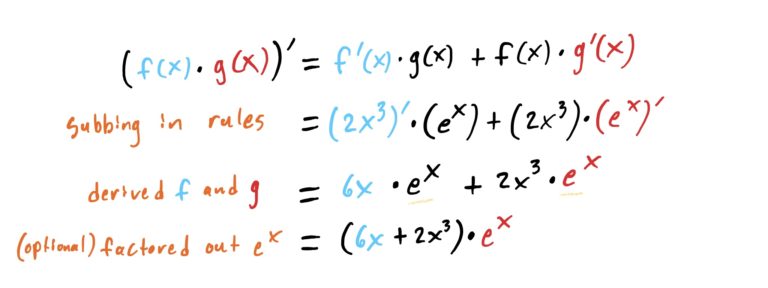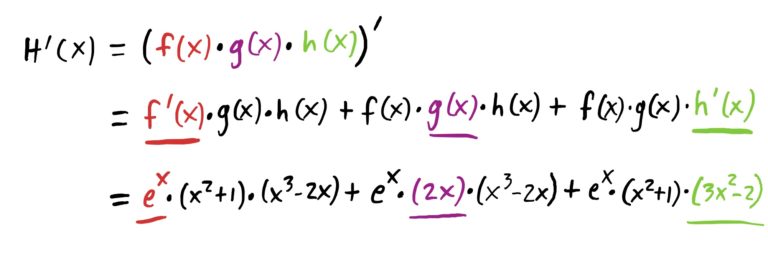Product Rule
Deriving Products of Functions
Up until now, we have discussed ways of deriving powers of \(x\), the natural exponential function \(e^x\), and linear combinations of these sorts of functions (i.e. these sorts of functions added or subtracts from one another, perhaps with constant coefficients, such as \(3x^4-2e^x+4\). Now how could we go about deriving products of functions, such as \(x^2\cdot e^x\)? Unfortunately, it is not as easy as just taking the derivative of \(x^2\) and \(e^x\) and multiplying the results. But it’s also not terribly complicated.
In other words, to find the derivative of a product \(f(x)\cdot g(x)\), derive the first function and leave the second alone, then derive the second and leave the first alone, and then add the results. Let’s see this method in action.
Since we have two functions being multiplied, namely \(2x^3\) and \(e^x\), we need to use the product rule. Letting \(f(x)=2x^3\) and \(g(x)=e^x\), the product rule gives us the following result.

Remember and repeat the following to yourself: “derive the first, leave the second alone, then derive the second, leaving the first alone… then add it all together”
Products of Multiple Functions
What does one do if you have multiple functions being multiplied? How do you derive something like
$$e^x\cdot(x^2+1)\cdot (x^3-2x)\ \ ?$$
It turns out that the rule for deriving a function with several functional factors, such as the above, is very similar to how one handles two functions being multipled.
That is, you derive the first function \(f\) in the first term, leaving the other two alone, derive the second function \(g\) in the second term, leaving the other two alone, and lastly derive the third function \(h\), leaving the other two alone. Then, you add it all together.
Let \(f(x)=e^x\), \(g(x)=x^2+1\) and \(h(x)=x^3-2x\). Then the three-function product rule says

Now, substituting in our \(f\), \(g\), and \(h\), we have

Once you get to this point, you certainly can FOIL/distribute out everything and combine like-terms, or even factor out an \(e^x\), but the problem didn’t ask us to simplify, so we wont. The last line above is the correct derivative, in all of its long-ass glory.
Remember: In the first term, derive the first function. In the second term, derive the second function, in the third term, derive the third function.
This idea above for deriving products can be generalized to four, five, or even more functions being multiplied!
Finding Tangent Lines with the Product Rule
The process of finding tangent lines using doesn’t change. We just have a new way of computing a function’s slope at a given point through use of the product rule. See the example below.
Remember, to find the tangent line at a given point, we need a slope \(m\) at that point and the \(x\) and \(y\)-values at that point as well. Let’s first compute \(m\) by finding the derivative of \(H\) at \(x=1\).
The function \(H\) is the same as the one given in a prior example. We found through the product rule that
$$\begin{align}H'(x)&=(2x^3\cdot e^x)’\\&=(6x+2x^3)\cdot e^x\end{align}$$
If you want to see how this was computed, click the dropdown below.

Note that
$$\begin{align}m&=H'(1)\\&=(6(1)+2(1)^3)e^1\\&=8e\\&\approx 21.74624\end{align}$$
Now that we have our slope, we need an \(x\) and \(y\)-value for the point that the function \(H\) and the tangent line have in common. We already are given the \(x\) value. To find the \(y\)-value, simply plug \(x\) into \(H\) (NOT \(H’\)). This gives us:
$$\begin{align} H(1)&=2(1)^3\cdot e^1\\&=2e\\&=5.43656\end{align}$$
In summary, we have \(m=21.74624\), \(x_0=1\), \(y_0=5.43656\). Plug this all into point-slope form \((y-y_0)=m(x-x_0)\). This gives us
$$(y-5.43656)=21.74624(x-1)$$
Solving for \(y\) gives us: \(y=21.74624x-16.30968\). The end!
Compute the following derivatives using the product rule.
Apply the product rule directly
Product Rule: \(\frac{d}{dx} f(x)\cdot g(x)=f'(x)\cdot g(x)+f(x)\cdot g'(x)\)
Product Rule Strategy: \((derive\ 1st\ function)(copy\ 2nd\ function)+(copy\ first\ function)(derive\ second\ function)\)
\((-2x)(x^3-x+1)+(2-x^2)(3x^2-1)\)
Apply the product rule directly
Product Rule: \(\frac{d}{dx} f(x)\cdot g(x)=f'(x)\cdot g(x)+f(x)\cdot g'(x)\)
Product Rule Strategy: \((derive\ 1st\ function)(copy\ 2nd\ function)+(copy\ first\ function)(derive\ second\ function)\)
\(e^x(1+x)\)
Apply the product rule directly
Product Rule: \(\frac{d}{dx} f(x)\cdot g(x)=f'(x)\cdot g(x)+f(x)\cdot g'(x)\)
Product Rule Strategy: \((derive\ 1st\ function)(copy\ 2nd\ function)+(copy\ first\ function)(derive\ second\ function)\)
\(xe^x(2+x)\)
Bring all powers of \(x\) up to numerator and make the exponent negative first
Product Rule: \(\frac{d}{dx} f(x)\cdot g(x)=f'(x)\cdot g(x)+f(x)\cdot g'(x)\)
Product Rule Strategy: \((derive\ 1st\ function)(copy\ 2nd\ function)+(copy\ first\ function)(derive\ second\ function)\)
\(\left(1-\frac{1}{x^2}\right)\left(\frac{1}{x^2}+x^2-5\right)+\left(x+\frac{1}{x}\right)\left(\frac{-2}{x^3}+2x\right)\)
Bring all powers of \(x\) up to numerator and make the exponent negative first
Product Rule: \(\frac{d}{dx} f(x)\cdot g(x)=f'(x)\cdot g(x)+f(x)\cdot g'(x)\)
Product Rule Strategy: \((derive\ 1st\ function)(copy\ 2nd\ function)+(copy\ first\ function)(derive\ second\ function)\)
\(\left(\frac{-16}{x^5}+\frac{1}{x^2}\right)\left(3x^2-\frac{1}{x^{2.1}}\right)+\left(\frac{4}{x^4}-\frac{1}{x}\right)\left(6x+\frac{2.1}{x^{3.1}}\right)\)
Write \(e^{2x}=e^x\cdot e^x\)
Product Rule: \(\frac{d}{dx} f(x)\cdot g(x)=f'(x)\cdot g(x)+f(x)\cdot g'(x)\)
Product Rule Strategy: \((derive\ 1st\ function)(copy\ 2nd\ function)+(copy\ first\ function)(derive\ second\ function)\)
\(2e^{2x}\)
Convert all radicals to fractional powers
Product Rule: \(\frac{d}{dx} f(x)\cdot g(x)=f'(x)\cdot g(x)+f(x)\cdot g'(x)\)
Product Rule Strategy: \((derive\ 1st\ function)(copy\ 2nd\ function)+(copy\ first\ function)(derive\ second\ function)\)
\(\left(2x^{-1/2}-\frac{1}{3}x^{-2/3}\right)\left(2x^{-2}-x^{1/5}\right)+\left(4x^{1/2}-x^{1/3}\right)\left(-4x^{-3}-\frac{1}{5}x^{-4/5}\right)\)
Convert all radicals to fractional powers
Product Rule: \(\frac{d}{dx} f(x)\cdot g(x)=f'(x)\cdot g(x)+f(x)\cdot g'(x)\)
Product Rule Strategy: \((derive\ 1st\ function)(copy\ 2nd\ function)+(copy\ first\ function)(derive\ second\ function)\)
\((3.2x^{2.2})(x^{-1/2}-x^{-2/5})+(x^{3.2}+5\pi)\left(\frac{-1}{2}x^{-3/2}+\frac{2}{5}x^{-7/5}\right)\)
Notice \((x^2+1)^2=(x^2+1)(x^2+1)\)
Product Rule: \(\frac{d}{dx} f(x)\cdot g(x)=f'(x)\cdot g(x)+f(x)\cdot g'(x)\)
Product Rule Strategy: \((derive\ 1st\ function)(copy\ 2nd\ function)+(copy\ first\ function)(derive\ second\ function)\)
\(4x(x^2+1)\)
Convert all radicals to fractional powers, and bring powers of \(x\) up to the numerator, making the exponents negative
Product Rule: \(\frac{d}{dx} f(x)\cdot g(x)=f'(x)\cdot g(x)+f(x)\cdot g'(x)\)
Product Rule Strategy: \((derive\ 1st\ function)(copy\ 2nd\ function)+(copy\ first\ function)(derive\ second\ function)\)
\(2\left(\frac{1}{2}x^{-1/2}-\frac{1}{2}x^{-3/2}\right)\left(x^{1/2}+x^{-1/2}\right)\)
Bring the \(x^2\) up to the numerator, negating the exponent. Then distribute it through the first factor \((x-1)\). Then apply product rule
Product Rule Strategy: \((derive\ 1st\ function)(copy\ 2nd\ function)+(copy\ first\ function)(derive\ second\ function)\)
Product Rule: \(\frac{d}{dx} f(x)\cdot g(x)=f'(x)\cdot g(x)+f(x)\cdot g'(x)\)
\((-x^{-2+2x^{-3}})(x^2+2x+1)+(x^{-1}-x^{-2})(2x+2)\)
Bring the \(x^{1/2}\) up to the numerator, then apply product rule
Product Rule Strategy: \((derive\ 1st\ function)(copy\ 2nd\ function)+(copy\ first\ function)(derive\ second\ function)\)
Product Rule: \(\frac{d}{dx} f(x)\cdot g(x)=f'(x)\cdot g(x)+f(x)\cdot g'(x)\)
\(\left(\frac{-1}{2}x^{-3/2}\right)(x^2+3x-1)+(x^{-1/2})(2x+3)\)
Apply the product rule directly. Note that we have three functions being multiplied here.
Product Rule on Three Factors: \(\frac{d}{dx} f(x)\cdot g(x) \cdot h(x)=f'(x)g(x)h(x)+f(x)g'(x)h(x)+f(x)g(x)h'(x)\)
The product rule on three functions produces three terms being added together. In the first term, the first function is derived, and everything else is just copy-pasted. In the second term, the second function is derived, and everything else is copy-pasted. Similarly for the third. This idea can be further generalized to as many functions as you like.
\(xe^x(x^2+2x-1)\)
Find the lines tangent to the graph of the functions below at the given point.
Start by computing the derivative of the function to get the slope formula of \(f\) at any given \(x\)-value.
- Point-Slope Formula: \((y-y_0)=m(x-x_0)\)
- Product Rule: \(\frac{d}{dx} f(x)\cdot g(x)=f'(x)\cdot g(x)+f(x)\cdot g'(x)\)
- Exponential Function Derivative: \(\frac{d}{dx}e^x=e^x\)
- Find \(y_0=f(x_0)\), i.e. the y-value of the given x-value (if not provided already)
- Compute \(f'(x)\)
- Compute \(m=f'(x_0)\), i.e. plug in given \(x\)-value into derivative found in step 2.
- Plug \(x_0,y_0,m\) into point-slope formula \((y-y_0)=m\cdot(x-x_0)\) and solve for \(y\).
\(y=2x+2\)
Start by computing the derivative of the function to get the slope formula of \(f\) at any given \(x\)-value.
- Point-Slope Formula: \((y-y_0)=m(x-x_0)\)
- Product Rule: \(\frac{d}{dx} f(x)\cdot g(x)=f'(x)\cdot g(x)+f(x)\cdot g'(x)\)
- Exponential Function Derivative: \(\frac{d}{dx}e^x=e^x\)
- Find \(y_0=f(x_0)\), i.e. the y-value of the given x-value (if not provided already)
- Compute \(f'(x)\)
- Compute \(m=f'(x_0)\), i.e. plug in given \(x\)-value into derivative found in step 2.
- Plug \(x_0,y_0,m\) into point-slope formula \((y-y_0)=m\cdot(x-x_0)\) and solve for \(y\).
\(y=3ex-2e\)
